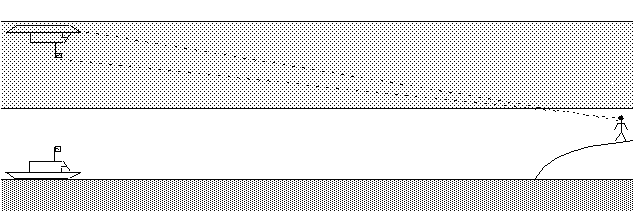Looming
As light from the sun passes through progressively denser layers of the atmosphere it is refracted towards the surface of the earth. To a terrestrial observer the sun therefore appears higher in the sky than it would if there were no atmosphere, and the angular difference between the apparent and actual positions increases as the sun approaches the horizon. For example, at the apparent angular altitudes of 45, 15, and 0 degrees, the differences are approximately 1, 4, and 35 minutes of arc. Coincidentally, the sun's disk spans 35 minutes of the sky, so when it seems to be tangent to the horizon at sunset it has really just dipped below the geometrical horizon. But because of refraction we continue to see it for at least another 2 minutes and 20 seconds. Unless the precise astronomical positions of objects are of concern to us, we take no notice of this 'ordinary' phenomenon. Occasionally, however, atmospheric anomalies cause light to bend in unusual ways, producing some rather striking 'extraordinary' visual phenomena, especially over water.
Within the troposphere (0-11 km) the air temperature decreases, on average, by about 6.5 deg-C/km (the lapse rate). There are, of course, perturbations to this general trend, especially near the earth's surface, where local heating and cooling processes produce the complicated and ever-changing distributions of air temperatures and densities that we call 'weather'. In particular, a temperature inversion may occur, where the air temperature actually increases with altitude over some limited portion of the atmosphere. This frequently occurs when a layer of warm air spreads over a cold body of water. Since the index of refraction of air is directly proportional to its density, which is inversely proportional to its temperature, it is clear that an inversion layer will amplify the normal rate of decrease of the index of refraction with altitude. This will cause light rays passing obliquely through the layer to be refracted more strongly towards the surface of the earth. The amount of additional bending, and hence the severity of the accompanying optical distortions will depend on the magnitude of the temperature gradient across the inversion layer.
Figure 1 shows, in an exaggerated way, what can happen when a strong enough inversion layer extends upwards from the surface of a body of water. Because of the enhanced bending effect, an object floating on the water appears to be suspended in the air. This optical illusion is known as looming.

When the bottom of the inversion layer is some distance above the water and the observer is slightly below the inversion layer, as in Figure 2, the illusion (a superior mirage)is even more dramatic: the observer not only sees the object by direct line of sight, but also an elevated and inverted image. In fact, directly above the inverted image there is usually yet another one, but this one is upright.

REFERENCES: .
W. J. Humphreys,, "Physics of the Air" (McGraw-Hill 1940), Part IV, Chapter 2.
M. G. J. Minnaert,, "Light and Colour in the Outdoors" (Springer-Verlag 1993), Chapter 4.


